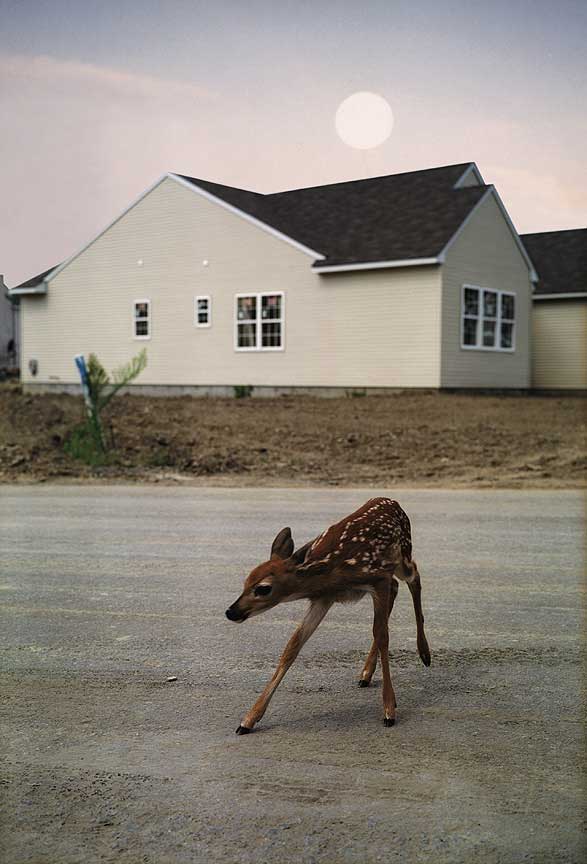
Pierre Huyghe, "Streamside Day," production still, 2003, Film and video transfers, 26 minutes, color, sound. Photo by Aaron S. Davidson. © Pierre Huyghe, courtesy Marian Goodman Gallery, Paris/New York.
The natural world is a marvel, a playground, an intrinsic adventure, a multi-layered curiosity, an embodiment of fear and absolute wonderment. It is an artists’ gym where one can exercise by wrapping his or her brain around concerns that affect us now and the efforts that sustain the pulsing planet that we inhabit. For the past few months, our blog discussion platform, Flash Points, has hosted a conversation on Art and the Environment. Together with our readers, we looked at how art reacts to the environment, and if it can be used as a way to contextualize and understand environmental concerns.
Flash Points Editor Rachel Craft kicked off the discussion:
From sustainability and alternative energy solutions, to green-collared jobs and maintaining a low carbon footprint, environmental concerns and how our world is addressing them is an ever-present issue. As artist Mark Dion stated [in the Art:21 Ecology episode], “We have a test ahead of us in terms of our relationship to the natural world. If we pass the test we get to keep the planet, but I don’t really see us doing a very good job of that right now.”
- Corinna Kirsch offered her insights on the importance of public art and sustainability in respect to the Twin Cities, Minnesota (Minneapolis / St. Paul), a forefront of what Grant Kesler of October Magazine might call an example of contemporary co-authorship. What could be more contemporary than a network of institutions and individuals collaboratively utilizing a public space in the name of art?
- What about becoming an activist? Stacy Ward Kelly speaks about the importance of using art as a tool to advocate for the preservation, restoration, and improvement of the natural environment.
- Julia Walker points out that many of the changes that need to occur in order for real sustainable architecture to thrive must take place in policy-making at the municipal, state, and federal levels.
- Nova Benway talks about art in relationship to sincerity and looks at sculptor David Olsen, whose work focuses on Newtown Creek in Brooklyn.
- Anna Kryczka quotes John Dewey and the understanding of art as an experience that is embodied in the Chinati Foundation: “every successive part flows freely without unfilled blanks into what ensues.” A moment of coherence—where art, architecture, landscape, and activity all enliven one another—is the art of the Chinati Foundation.
- Catherine Wagley looks at what happens when nature takes over. Much of the talk about climate change and green living focuses on common missions and shared responsibility to nature. So how much of this conversation is really about preserving ourselves?
- Catherine also attended “What’s at Stake? New Topographics and the Man-Altered Landscape,” a LACMA symposium focused on restaging the 1975 exhibition with regard to curatorial practice, urbanism, environmentalism, and architecture.
- Inhale. Exhale. Whew. Nicole Caruth explores the power of positive thinking in relationship to climate change.
- Kevin Buist sees the link between the work of Robert Smithson and Eames Demetrios in how they both marry natural sites with epic mythologies.
Among the many related posts of the last few months, there were numerous interviews that focused on art and the environment in different ways, including:
- Flash Points Editor Rachel Craft interviewed David R. Collens, Director and Curator of Storm King Art Center, about the institution’s focus on the relationship between art and nature. How does the interaction between art and nature inform the core of Storm King’s programming?
- Andrea Zittel is building a floating island in Indiana. Richard McCoy interviews her about this project.
- The wonder years are here to stay. Find some slug eggs, make the light bulb light up, get the microscope to focus, harvest a tomato, nurture a seed…it’s wonderful! Joe Fusaro interviews Abbe Futterman, former graduate of the Pratt Institute and now a science teacher at the Earth School, about the importance of drawing and scientific illustration as a unique way of exploring the world.
- Nicole Sansone conducts a “blogalogue” with EcoArtTech, a collaborative platform for digital environmental art (also here), as well as talks with ETeam.
- Matthias Merkel Hess interviews Catherine Page Harris, a professor of the new Art and Ecology program at the University of New Mexico.
Honing in on another facet of the conversation, artists speak about their artistic processes, projects and recent exhibitions:
- Roni Horn discusses the paradoxical identity and dependency of water, paired with scenes of Icelandic landscapes in this video exclusive.
- Alexis Avlamis: “I use the highly fluid state of encaustic to document and elaborate constant movement and changes reminiscent of weather, rock and cloud patterns, veins, markings, organs, rivers, cast shadows, biomorphic figures, and creatures…”
- Eirik Johnson returned to the Northwest to make work that addressed the complicated relationship between the region’s landscape, industries that rely upon natural resources, and the communities they support.
- Ariana Page Russell uses her skin condition as a tool and her body as a canvas in self-exploration.
- Noah Fischer writes about his site-specific installation, Electric Forest: Made in Troy.
- Katie Holten features her current project, Tree Museum, a public artwork in the Bronx, New York.
Is there anything that you would like to add to this discussion? Who are the artists in your community and what institution(s) do you see utilizing art as a tool to understand our environment?




Pingback: What’s Cookin at the Art21 Blog: A Weekly Index | Art21 Blog